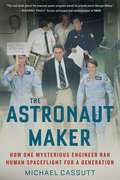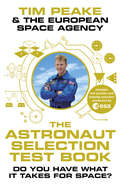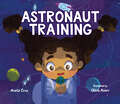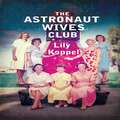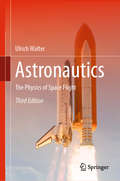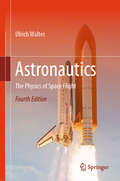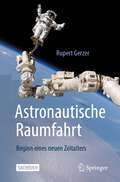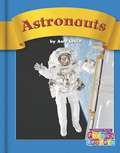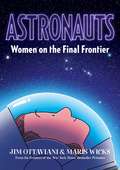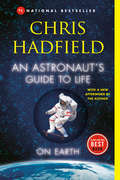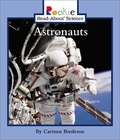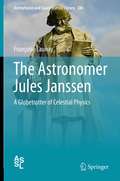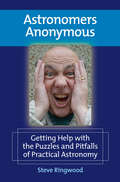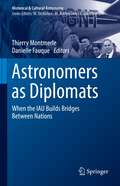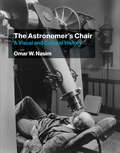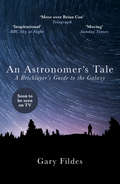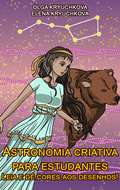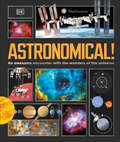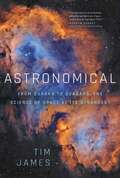- Table View
- List View
The Astronaut Maker: How One Mysterious Engineer Ran Human Spaceflight for a Generation
by Michael Cassutt"The real book about the manned space program would be a book about George Abbey." —Richard Truly, former astronaut and Administrator of NASA. <p><p>One of the most elusive and controversial figures in NASA's history, George W. S. Abbey was called "the Dark Lord," "the Godfather," and "UNO" (unidentified NASA official) by those within NASA. He was said to be secretive, despotic, a Space Age Machiavelli. Yet Abbey had more influence on human spaceflight than almost anyone in history. <p><p>From young pilot and wannabe astronaut to engineer, bureaucrat, and finally director of the Johnson Space Center ("mission control"), Abbey's story has never been fully told—until now. <p><p>The Astronaut Maker takes readers inside NASA to learn the real story of how Abbey rose to power and wielded it out of the spotlight. Over a 37-year career he oversaw the selection of every astronaut class from 1978 to 1987, deciding who got to fly, and when; was with the Apollo 1 astronauts the night before the fire that killed them in January 1967; was in mission control the night of the Apollo 13 accident and organized the recovery effort; led NASA's recruitment of women and minorities as Space Shuttle astronauts—including hiring Sally Ride; and much more. <p><p>By the coauthor of the acclaimed astronaut memoirs DEKE! and We Have Capture and informed by countless hours of interviews with Abbey and his family, friends, adversaries, and former colleagues, The Astronaut Maker is the ultimate insider's account of ambition and power politics at NASA.
The Astronaut Selection Test Book: Do You Have What It Takes For Space?
by Tim Peake and The European Space AgencyAstronaut Training
by Aneta CruzWhen Astrid's first space mission goes disastrously wrong, she realizes she needs a bit more training than she thought!Astrid is training to go to space! But as she builds her shuttle, cooks astronaut food, and practices floating in zero gravity, Dad tells Astrid that the ship's construction is too dangerous, she's too little to cook alone, and she's not allowed to flood the bathroom. That night, when Astrid dreams she's an astronaut, the challenges she encounters are overwhelming. Astrid realizes she isn't as ready as she thought. Back on Earth, Astrid turns to her loving and supportive Dad, who helps Astrid continue her astronaut training.
The Astronaut Who Painted the Moon: The True Story Of Alan Bean
by Dean RobbinsJourney to the moon on the Apollo 12 mission with Alan Bean, the fourth astronaut to walk on the lunar surface and the only artist to paint its beauty firsthand!As a boy, Alan wanted to fly planes. As a young navy pilot, Alan wished he could paint the view from the cockpit. So he took an art class to learn patterns and forms. But no class could prepare him for the beauty of the lunar surface some 240,000 miles from Earth. In 1969, Alan became the fourth man and first artist on the moon. He took dozens of pictures, but none compared to what he saw through his artistic eyes. When he returned to Earth, he began to paint what he saw. Alan's paintings allowed humanity to experience what it truly felt like to walk on the moon. Journalist and storyteller Dean Robbins's tale of this extraordinary astronaut is masterful, and artist Sean Rubin's illustrations are whimsical and unexpected. With back matter that includes photos of the NASA mission, images of Alan's paintings, and a timeline of lunar space travel, this is one adventure readers won't want to miss!
The Astronaut Wives Club: A True Story
by Lily KoppelAs American astronauts were launched on death-defying missions, television cameras focused on the brave smiles of their wives. Overnight, these women were transformed from shy military spouses to American royalty: having tea with Jackie Kennedy, attending high society galas, and being featured on the cover of Life magazine. They quickly grew into fashion icons, donning sherbet-swirled Pucci dresses and lacquering their hair into extravagant rocket styles (to match their husbands' spaceships).Annie Glenn was the envy of the other wives, with her many magazine features; platinum-blonde bombshell Rene Carpenter was proclaimed JFK's favourite; homely Betty Grissom worried her husband was having affairs; Louise Shepard just wanted to be left alone to her card games; and licensed pilot Trudy Cooper arrived on base with a dirty secret. Together they rallied to form the Astronaut Wives Club, which has now turned into over 40 years of enduring friendship. Sexy and sophisticated, rich in melodrama, and set against the uniquely atmospheric backdrop of the Space Age, THE ASTRONAUTS' WIVES CLUB tells the real story behind some of the biggest heroes in American history, chronicling their romantic, domestic, and public dramas during the Mad Men era.
The Astronaut Wives Club
by Lily KoppelAs American astronauts were launched on death-defying missions, television cameras focused on the brave smiles of their wives. Overnight, these women were transformed from shy military spouses to American royalty: having tea with Jackie Kennedy, attending high society galas, and being featured on the cover of Life magazine. They quickly grew into fashion icons, donning sherbet-swirled Pucci dresses and lacquering their hair into extravagant rocket styles (to match their husbands' spaceships).Annie Glenn was the envy of the other wives, with her many magazine features; platinum-blonde bombshell Rene Carpenter was proclaimed JFK's favourite; homely Betty Grissom worried her husband was having affairs; Louise Shepard just wanted to be left alone to her card games; and licensed pilot Trudy Cooper arrived on base with a dirty secret. Together they rallied to form the Astronaut Wives Club, which has now turned into over 40 years of enduring friendship. Sexy and sophisticated, rich in melodrama, and set against the uniquely atmospheric backdrop of the Space Age, THE ASTRONAUTS' WIVES CLUB tells the real story behind some of the biggest heroes in American history, chronicling their romantic, domestic, and public dramas during the Mad Men era.(P)2013 Headline Digital
Astronautics: The Physics of Space Flight
by Ulrich WalterThis introductory text covers all the key concepts, relationships, and ideas behind spaceflight and is the perfect companion for students pursuing courses on or related to astronautics. As a crew member of the STS-55 Space Shuttle mission and a full professor of astronautics at the Technical University of Munich, Ulrich Walter is an acknowledged expert in the field. This book is based on his extensive teaching and work with students, and the text is backed up by numerous examples drawn from his own experience. With its end-of-chapter examples and problems, this work is suitable for graduate level or even undergraduate courses in spaceflight, as well as for professionals working in the space industry. This third edition includes substantial revisions of several sections to extend their coverage. These include both theoretical extensions such as the study of relative motion in near-circular orbits, and more practical matters such as additional details about jet-engine and general rocket performance. New sections address regularized equations of orbital motion and their algebraic solutions and also state vector propagation; two new chapters are devoted to orbit geometry and orbit determination and to thermal radiation physics and modelling.
Astronautics: The Physics of Space Flight
by Ulrich WalterThis book covers all the key concepts, relationships, and ideas behind spaceflight and is the perfect companion for students pursuing courses on, or related to, astronautics. As a crew member of the STS-55 Space Shuttle mission and a full professor of astronautics at the Technical University of Munich, Ulrich Walter is an acknowledged expert in the field. This book is based on his extensive teaching and work with students, and the text is backed up by numerous examples drawn from his own experience. With its end-of-chapter examples and problems, this book is suitable for graduate level or even undergraduate courses in spaceflight, as well as for professionals working in the space industry. This fourth edition includes substantial revisions of many sections to extend their coverage. These include an overview of the different approaches to solving Newton’s gravitational equation of motion, a concise and newly structured coverage of orbital maneuvering, an enlarged and improved sectionabout the sphere of influence, a new section about hierarchical three-body systems, major enlargements in space reference frames and orbit geometry, and a new section about the earth reference ellipsoid.
Astronautische Raumfahrt: Beginn eines neuen Zeitalters
by Rupert GerzerWelche Auswirkungen haben Raumflüge auf Menschen? Was wird in Bettruhestudien und Zentrifugen erforscht? Wie trainiert man Astronautinnen und Astronauten? Mit dem vorliegenden Buch gibt Rupert Gerzer, Begründer des :envihab (DLR, Köln), einen Überblick über den aktuellen Stand der astronautischen Raumfahrt. Von den Grundlagen der Raketentechnik über derzeitige Entwicklungen in der Privatindustrie zu Astronautentraining und lebenswissenschaftlicher Forschung — Leserinnen und Leser erfahren, welche Chancen und Möglichkeiten eine astronautische Raumfahrt hat und welche Gefahren sie birgt.Der Autor bespricht verständlich physikalische und technische Grundlagen und lässt unterhaltsame Anekdoten aus seiner Arbeit als Leiter des Instituts für Luft- und Raumfahrtmedizin einfließen. Das Buch gibt damit Einblicke hinter die Kulissen und begeistert Leserinnen und Leser für astronautische Raumfahrt als wichtiges Zukunftsthema.Aus dem InhaltKurzer Überblick über die Geschichte der astronautischen RaumfahrtRahmenbedingungen im WeltraumAufenthalt in der SchwerelosigkeitRaketen, Raumschiffe und RaumstationenRaumanzügeKünftige Mond- und MarsstationenAkteure der astronautischen RaumfahrtWie wird man Astronaut oder Astronautin?Auswirkung von Raumflügen auf den MenschenLebenswissenschaftliche Forschung
Astronauts
by Amy LevinPhonics Readers is a recognized leader in helping you teach phonics and phonemic awareness, within the context of content-area reading. Content area focus: Space Explorers Phonics Skills: long o (o, oa, oe, ow), soft c
Astronauts: Women on the Final Frontier
by Jim OttavianiIn the graphic novel Astronauts: Women on the Final Frontier, Jim Ottaviani and illustrator Maris Wicks capture the great humor and incredible drive of Mary Cleave, Valentina Tereshkova, and the first women in space.The U.S. may have put the first man on the moon, but it was the Soviet space program that made Valentina Tereshkova the first woman in space. It took years to catch up, but soon NASA’s first female astronauts were racing past milestones of their own. The trail-blazing women of Group 9, NASA’s first mixed gender class, had the challenging task of convincing the powers that be that a woman’s place is in space, but they discovered that NASA had plenty to learn about how to make space travel possible for everyone. <P><P><i>Advisory: Bookshare has learned that this book offers only partial accessibility. We have kept it in the collection because it is useful for some of our members. Benetech is actively working on projects to improve accessibility issues such as these.</i>
The Astronaut's Guide to Leaving the Planet: Everything You Need to Know, from Training to Re-entry
by Terry VirtsA former NASA astronaut inspires the next generation of space travelers with answers to all kids' questions on how people become astronauts, how they prepare for space travel, and what it's like to live and work in space.
An Astronaut's Guide to Life on Earth: What Going To Space Taught Me About Ingenuity, Determination, And Being Prepared For Anything
by Chris HadfieldAs Commander of the International Space Station, Chris Hadfield captivated the world with stunning photos and commentary from space. Now, in his first book, Chris offers readers extraordinary stories from his life as an astronaut, and shows how to make the impossible a reality. Chris Hadfield decided to become an astronaut after watching the Apollo moon landing with his family on Stag Island, Ontario, when he was nine years old, and it was impossible for Canadians to be astronauts. In 2013, he served as Commander of the International Space Station orbiting the Earth during a five-month mission. Fulfilling this lifelong dream required intense focus, natural ability and a singular commitment to &“thinking like an astronaut.&” In An Astronaut&’s Guide to Life on Earth, Chris gives us a rare insider&’s perspective on just what that kind of thinking involves, and how earthbound humans can use it to achieve success and happiness in their lives.Astronaut training turns popular wisdom about how to be successful on its head. Instead of visualizing victory, astronauts prepare for the worst; always sweat the small stuff; and do care what others think. Chris shows how this unique education comes into play with dramatic anecdotes about going blind during a spacewalk, getting rid of a live snake while piloting a plane, and docking with space station Mir when laser tracking systems fail at the critical moment. Along the way, he shares exhilarating experiences, and challenges, from his 144 days on the ISS, and provides an unforgettable answer to his most-asked question: What&’s it really like in outer space?Written with humour, humility and a profound optimism for the future of space exploration, An Astronaut&’s Guide to Life on Earth offers readers not just the inspiring story of one man&’s journey to the ISS, but the opportunity to step into his space-boots and think like an astronaut—and renew their commitment to pursuing their own dreams, big or small.
An Astronaut's Guide to Life on Earth
by Chris HadfieldAs Commander of the International Space Station, Chris Hadfield captivated the world with stunning photos and commentary from space. Now, in his first book, Chris offers readers extraordinary stories from his life as an astronaut, and shows how to make the impossible a reality. Chris Hadfield decided to become an astronaut after watching the Apollo moon landing with his family on Stag Island, Ontario, when he was nine years old, and it was impossible for Canadians to be astronauts. In 2013, he served as Commander of the International Space Station orbiting the Earth during a five-month mission. Fulfilling this lifelong dream required intense focus, natural ability and a singular commitment to "thinking like an astronaut." In An Astronaut's Guide to Life on Earth, Chris gives us a rare insider's perspective on just what that kind of thinking involves, and how earthbound humans can use it to achieve success and happiness in their lives.Astronaut training turns popular wisdom about how to be successful on its head. Instead of visualizing victory, astronauts prepare for the worst; always sweat the small stuff; and do care what others think. Chris shows how this unique education comes into play with dramatic anecdotes about going blind during a spacewalk, getting rid of a live snake while piloting a plane, and docking with space station Mir when laser tracking systems fail at the critical moment. Along the way, he shares exhilarating experiences, and challenges, from his 144 days on the ISS, and provides an unforgettable answer to his most-asked question: What's it really like in outer space?Written with humour, humility and a profound optimism for the future of space exploration, An Astronaut's Guide to Life on Earth offers readers not just the inspiring story of one man's journey to the ISS, but the opportunity to step into his space-boots and think like an astronaut--and renew their commitment to pursuing their own dreams, big or small.
Astronauts (Rookie Read-About Science)
by Carmen Bredeson"Introduces the work of astronauts, including special jobs they might have on the space shuttle and experiments they might perform in space. Includes index." Other books in this series are available in this library.
The Astronomer Jules Janssen
by Françoise LaunayA physicist and an inventor, Jules Janssen (1824-1907) devoted his life to astronomical research. He spent many years traveling around the world to observe total Solar eclipses, demonstrating that a new era of science had just come thanks to the use of both spectroscopy and photography, and persuading the French Government of the necessity of founding a new observatory near Paris. He became its director in 1875. There, at Meudon, he began routine photographic recordings of the Sun surface and had a big refractor and a big reflector built. Meanwhile, he also succeeded in building an Observatory at the summit of Mont-Blanc. The story of this untiring and stubborn globe-trotter is enriched by extracts of the unpublished correspondence with his wife. One can thus understand why Henriette often complained of the solitude in which she was left by her peripatetic husband: "There are men who leave their wives for mistresses; you do it for journeys!" ... Basking in the glow of his success, Janssen was able to undertake the construction of the great astrophysical observatory of which he had dreamed. It was at Meudon that he had it built.
Astronomers Anonymous: Getting Help with the Puzzles and Pitfalls of Practical Astronomy
by Steve RingwoodThis collection of "typical" astronomy questions and hilarious answers, compiled from Ringwood's own experiences in the world of astronomy, has been written to entertain and amuse amateur (and professional) astronomers as well as armchair astronomers. In this parody of a typical "Lonely Hearts column", specifically for troubled astronomers, readers will easily recognize the difficulties they face and enjoy the laughs being directed at them and their science. There is also plenty of background material provided to make the book accessible to non-astronomers, as a humorous and informative work about (mostly amateur) astronomy.
Astronomers as Diplomats: When the IAU Builds Bridges Between Nations (Historical & Cultural Astronomy)
by Thierry Montmerle Danielle FauqueThis book illuminates a few highly significant events in history in which astronomers have helped keep contacts between astronomers of different states in moments of international political tensions or even crises. The chapters, written by 20 international authors, focus on four periods where astronomers were particularly active in international relations:1. The WWI period, the epoch of the creation of the IAU, in the context of the simultaneous creation of other scientific unions. The book also singles out the important role of A.S. Eddington and his network “across forbidden borders”.2. The Cold war period and its consequences, when several countries were divided between opposite blocs. “The China crisis” is told here from different viewpoints by Chinese astronomers, both from the mainland and from Taiwan, in parallel with the evolution of astronomy in South and North Korea. Germany’s twisted path in its membership of the IAU, from its admission in 1951 to its reunification in 1991 is shown as another example.3. The book then highlights a third period, when radio astronomers, in particular, were very active in “building bridges” between East and West. It also tells the history of how the apparently innocuous issue of the “lunar nomenclature” became extremely sensitive. The part ends on two chapters on Russian robotic missions and lunar surface features as well on the Russian participation in the “International Virtual Observatory” project.4. The fourth part reports for the first time on the “hidden story” of the relations between the IAU and the United Nations after the “Moon race” when the United Nations decided to challenge the IAU’s authority on “extraterrestrial names”. The final chapter reviews how twenty years later UNESCO and the IAU had become strong partners in the difficult, but highly successful organization of the International Year of Astronomy (2002-2009), and of the “Astronomy and World Heritage” intitiative (2008).
The Astronomer's Chair: A Visual and Cultural History
by Omar W. NasimThe astronomer&’s observing chair as both image and object, and the story it tells about a particular kind of science and a particular view of history.The astronomer&’s chair is a leitmotif in the history of astronomy, appearing in hundreds of drawings, prints, and photographs from a variety of sources. Nineteenth-century stargazers in particular seemed eager to display their observing chairs—task-specific, often mechanically adjustable observatory furniture designed for use in conjunction with telescopes. But what message did they mean to send with these images? In The Astronomer&’s Chair, Omar W. Nasim considers these specialized chairs as both image and object, offering an original framework for linking visual and material cultures. Observing chairs, Nasim ingeniously argues, showcased and embodied forms of scientific labor, personae, and bodily practice that appealed to bourgeois sensibilities. Viewing image and object as connected parts of moral, epistemic, and visual economies of empire, Nasim shows that nineteenth-century science was represented in terms of comfort and energy, and that &“manly&” postures of Western astronomers at work in specialized chairs were contrasted pointedly with images of &“effete&” and cross-legged &“Oriental&” astronomers. Extending his historical analysis into the twentieth century, Nasim reexamines what he argues to be a famous descendant of the astronomer&’s chair: Freud&’s psychoanalytic couch, which directed observations not outward toward the stars but inward toward the stratified universe of the psyche. But whether in conjunction with the mind or the heavens, the observing chair was a point of entry designed for specialists that also portrayed widely held assumptions about who merited epistemic access to these realms in the first place. With more than 100 illustrations, many in color; flexibound.
An Astronomer's Tale: A Bricklayer’s Guide to the Galaxy
by Gary FildesA Bricklayer's Guide to the Galaxy . . . The inspirational memoir of a former brickie who followed his passion for the stars and built his own observatory. Perfect for readers of Robert Macfarlane, Helen Macdonald and James Rebanks - as well as fans of Brian Cox and the BBC’s Sky at Night Gary Fildes left school at sixteen, got a trade like most of his mates and was soon married with four kids. His life seemed set. But he had a secret. Something he only practised late at night with a few like-minded friends. Then one day, middle age approaching alarmingly, he acted on his lifelong passion. He finally came out. As an astronomer.Today, Gary is the founder and lead astronomer of Kielder Observatory, one of the top ten stargazing sites in the world, which he also helped to build. Situated in the beautiful forests of Kielder, Northumberland, within Europe’s largest protected dark sky park, it offers some of the UK's most spectacular views of stars, planets and galaxies.An Astronomer’s Tale is Gary’s inspirational story: part memoir, part nature writing, part seasonal guide to the night sky. It is a book brimming with passion; and at a time when the world is captivated by space, it will leave you ready to get out there and explore the wonders of the skies for yourself.
Astronomia criativa para estudantes. Leia e dê cores aos desenhos!
by Olga Kryuchkova Elena KryuchkovaNeste livro, você vai aprender sobre o planeta Terra e seu satélite natural (a Lua), sobre outros planetas do Sistema Solar e sobre uma série de constelações. Você pode não apenas obter informações úteis, acessíveis e interessantes, como também colorir ilustrações em preto e branco que exibem a imagem mitológica de um determinado planeta ou de uma constelação.
Astronomical!: An Awesome Encounter with the Wonders of the Universe
by DKAn awesome encounter with the wonders of the Universe.Behold a cosmic treasure trove of spectacular photographs that captures space as you've never seen it before in this space book for children aged 9+.Mind-blowing new images made possible by the latest technology can now take us to the heart of the Universe–from swirling dust devils on Mars, to emerging stars in nebulas, supermassive storms on Jupiter, as well as galaxies, comets, asteroids, and much more.This space book for children offers: Fast facts and amazing stats that highlight the mind-blowing wonders of the Solar System and the Universe.A collection of spectacular images captured by the latest space telescope, the James Webb, as well as mesmerizing images from Hubble and other spacecraft.Content endorsed and authenticated by Smithsonian.Astronomical! is the perfect gift to inspire young stargazers and astronomers. Every double page features a magnificent celestial body alongside fascinating and informative text that brings to life the wonder of outer space. Additional facts and comparisons provide readers with key information at a glance.
Astronomical: From Quarks to Quasars, the Science of Space at its Strangest
by Tim James'In the same light-heartedly informative spirit as his previous Elemental, Tim James gives us an entertaining gallop through light years of space science, from the big bang to UFOs'Andrew Crumey, author of The Great Chain of UnbeingPRAISE FOR THE AUTHOR'Humorous, yet deep . . . Fundamental will speak to all readers' Professor Charles Antoine, Sorbonne University'Who said science was dry? Certainly not Tim James' New York PostDoes the Big Bang prove the existence of God? What's the Universe expanding into? Is Earth the only planet which supports life? Why did the greatest astronomer in history murder his pet moose?Space is the biggest, oldest, hottest, coldest, strangest thing a human can study. It's no surprise then, that the weirdest facts in science (not to mention the weirdest scientists themselves) are found in astrophysics and cosmology. If you're looking for instructions on how to set up your grandad's telescope this book probably isn't for you. In Astronomical, Tim James takes us on a tour of the known (and unknown) Universe, focusing on the most-mind boggling stuff we've come across, as well as unpacking the latest theories about what's really going on out there.Guiding us through Einstein's relativity, quantum mechanics and string theory, Astronomical delves into the baffling corners of the cosmos and tackles the biggest mysteries we face: from alien life to the zodiac; from white holes to wormholes; from quasars to quark stars. This is the science of space at its absolute strangest! From the creation of the Universe out of nothing to the Large Hadron Collider and the Universe's ongoing expansion, Tim explores our planetary neighbours, where it snows metal on Venus, there are underground lakes on Mars and rivers of petrol on Titan. He then looks beyond our solar system: to exoplanets which could support life, rogue planets, quark stars, quasars, neutron stars and more. Tim looks at black holes (and how to survive in one), wormholes, white holes as well as dark energy, dark matter and even a bit of string theory thrown in for good measure. He explains the search for extra-terrestrial intelligence, including the discovery of Martian fossils in the Alan Hills meteorite and the tantalising 'Wow signal' transmission earth received in 1973 - still unexplained. He also rebuts resurgent anti-science movements, including the Flat Earth Society and discusses what's really going on inside Area 51.To close, Tim finishes by looking at human achievements in space including how rockets work, how faster-than-light warp-drives (currently being investigated by NASA) work and how we plan to colonise both the moon and Mars.
Astronomical: From Quarks to Quasars: The Science of Space at its Strangest
by Tim JamesGuiding us through Einstein's theory of relativity, quantum mechanics, and string theory, Astronomical explains the baffling mysteries of the cosmos: from alien life to the zodiac; from white holes to wormholes; from quasars to quark stars—all within a narrative that is as entertaining as it is edifying.Does the Big Bang prove the existence of God? What's the Universe expanding into? Is Earth the only planet which supports life? Space is the biggest, oldest, hottest, coldest, strangest thing a human can study. It's no surprise then, that the weirdest facts in science (not to mention the weirdest scientists themselves) are found in astrophysics and cosmology. If you're looking for instructions on how to set up your grandad's telescope this book probably isn't for you. In Astronomical, Tim James takes us on a tour of the known (and unknown) universe, focusing on the most-mind boggling stuff we've come across, as well as unpacking the latest theories about what's really going on out there. Guiding us through Einstein's relativity, quantum mechanics and string theory, Astronomical delves into the baffling corners of the cosmos and tackles the biggest mysteries we face: from alien life to the zodiac; from white holes to wormholes; from quasars to quark stars. This is the science of space at its absolute strangest.
Astronomical: From Quarks to Quasars, the Science of Space at its Strangest
by Tim James'In the same light-heartedly informative spirit as his previous Elemental, Tim James gives us an entertaining gallop through light years of space science, from the big bang to UFOs'Andrew Crumey, author of The Great Chain of UnbeingPRAISE FOR THE AUTHOR'Humorous, yet deep . . . Fundamental will speak to all readers' Professor Charles Antoine, Sorbonne University'Who said science was dry? Certainly not Tim James' New York PostDoes the Big Bang prove the existence of God? What's the Universe expanding into? Is Earth the only planet which supports life? Why did the greatest astronomer in history murder his pet moose?Space is the biggest, oldest, hottest, coldest, strangest thing a human can study. It's no surprise then, that the weirdest facts in science (not to mention the weirdest scientists themselves) are found in astrophysics and cosmology. If you're looking for instructions on how to set up your grandad's telescope this book probably isn't for you. In Astronomical, Tim James takes us on a tour of the known (and unknown) Universe, focusing on the most-mind boggling stuff we've come across, as well as unpacking the latest theories about what's really going on out there.Guiding us through Einstein's relativity, quantum mechanics and string theory, Astronomical delves into the baffling corners of the cosmos and tackles the biggest mysteries we face: from alien life to the zodiac; from white holes to wormholes; from quasars to quark stars. This is the science of space at its absolute strangest! From the creation of the Universe out of nothing to the Large Hadron Collider and the Universe's ongoing expansion, Tim explores our planetary neighbours, where it snows metal on Venus, there are underground lakes on Mars and rivers of petrol on Titan. He then looks beyond our solar system: to exoplanets which could support life, rogue planets, quark stars, quasars, neutron stars and more. Tim looks at black holes (and how to survive in one), wormholes, white holes as well as dark energy, dark matter and even a bit of string theory thrown in for good measure. He explains the search for extra-terrestrial intelligence, including the discovery of Martian fossils in the Alan Hills meteorite and the tantalising 'Wow signal' transmission earth received in 1973 - still unexplained. He also rebuts resurgent anti-science movements, including the Flat Earth Society and discusses what's really going on inside Area 51.To close, Tim finishes by looking at human achievements in space including how rockets work, how faster-than-light warp-drives (currently being investigated by NASA) work and how we plan to colonise both the moon and Mars.
